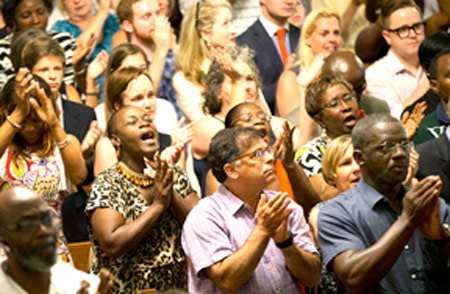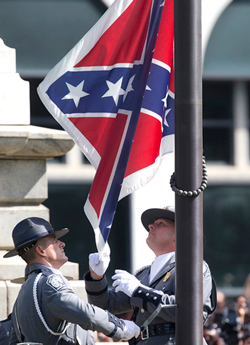The Confederate battle flag, a rallying point for racist thugs and opponents of Black rights since it was unfurled over the Statehouse in 1961, was removed from the South Carolina state Capitol at 10 a.m. July 10.
A cheering crowd of thousands began gathering hours earlier. The flag will be put in the Confederate Relic Room and Military Museum. A few in the crowd carried the Confederate banner, without incident.
Millions around the world watched as the historic event was televised live.
The decision to remove the flag, its rapidity, the overwhelming bipartisan political support for it — all are the product of the powerful struggle led by African-Americans in the 1950s and ’60s that overthrew Jim Crow segregation and its social and political consequences over decades. Those battles transformed the consciousness of the U.S. population.
The demise of this racist emblem came three weeks after 21-year-old white supremacist terrorist Dylann Storm Roof shot dead nine African-Americans at the Emanuel African Methodist Episcopal Church in Charleston during a prayer meeting. Those killed were Clementa Pinckney, the church pastor and a state senator, Sharonda Singleton, Daniel Simmons, Ethel Lee Lance, Cynthia Hurd, Myra Thompson, Susie Jackson, DePayne Middleton-Doctor and Tywanza Sanders.
The dignified response of the Black community in Charleston — their disciplined refusal to be provoked into vengeful retaliatory acts, as Roof hoped they would be — set the tone. There was a broad, sustained outpouring to remember the dead and denounce the slaughter, in vigils, memorials and Pinckney’s funeral at the College of Charleston’s TD Arena.
Black-led struggle changed millions
The battle flag, originally a wartime banner of the slave owners who seceded from the Union in 1861, became a symbol of Ku Klux Klan terror to overturn Reconstruction governments established after the defeat of the Confederacy, and then of terrorist defiance of the rising fight of African-Americans and their allies in the 1950s and ’60s to end Jim Crow segregation.But the Black-led fight to combat racist laws and terror prevailed, helping bring about a transformation in the social outlook of tens of millions of people.
Roof told friends he wanted to spark a race war. He posted photos of himself with the Confederate battle flag on a white supremacist website. Before killing his victims he told them, “You’ve raped our women and you are taking over our country.”
He was arrested June 18. When he appeared on video at a court hearing the next day, family members of the people he killed one by one spoke with dignity and determination, expressing forgiveness not revenge.
In the days after the massacre, thousands came to pay their respects outside the Emanuel Church. The church reopened for services June 21. That evening more than 10,000 people walked hand in hand across Charleston’s Ravenel Bridge.
The breadth and power of the response caught the ruling class and the politicians and media that represent them off guard.
Republican Gov. Nikki Haley had previously opposed demands to take down the flag and continued to do so in the first days after the killing. But on June 22 she held a press conference in the state Capitol — surrounded by the state’s two U.S. senators, Republicans Tim Scott and Lindsey Graham, Democratic Congressman Jim Clyburn, Republican Congressman and former Gov. Mark Sanford and Charleston Mayor Joe Riley — to say the time had come to remove the flag from the Capitol.
Thousands stood in line to honor Pinckney as his body lay in state under the Capitol dome June 24. A horse-drawn caisson carried the coffin into the building as Haley presided.
Obama speaks at Pinckney’s funeral
President Barack Obama delivered the eulogy at the June 26 funeral service for Pinckney and memorial for all nine people killed. It was attended by some 6,000 people, with hundreds more turned away. Republican House Speaker John Boehner, First Lady Michelle Obama, Vice President Joe Biden and his wife Dr. Jill Biden, former Secretary of State Hillary Clinton, Gov. Haley and Mayor Riley all attended.Obama, in what will likely be the most remembered speech of his presidency, talked of the long history of the Black church as a center to organize resistance to slavery and Jim Crow. They “served as ‘hush harbors’ where slaves could worship in safety; praise houses where their free descendants could gather and shout hallelujah; rest stops for the weary along the Underground Railroad; bunkers for the foot soldiers of the Civil Rights Movement,” he said.
To many in the audience who knew the history of the Black rights struggle — firsthand or from study of the battles in Montgomery, Birmingham and Selma, Alabama; Jackson, Mississippi; and elsewhere — that description rang true.
It was no surprise, Obama said, that Pinckney was targeted for being both a clergyman and a public figure in the Black rights fight, or that Mother Emanuel, as Pinckney’s church is known, has a long history of struggle. It was “built by Blacks seeking liberty, burned to the ground because its founder sought to end slavery, only to rise up again, a Phoenix from these ashes.” Denmark Vesey, a carpenter and freed slave who was a founding member of the church, planned a failed slave uprising in 1822 for which he was executed. Mother Emanuel was destroyed in retaliation.
Removing the Confederate battle flag from the Capitol, Obama said, “would not be an act of political correctness; it would not be an insult to the valor of Confederate soldiers. It would simply be an acknowledgment that the cause for which they fought — the cause of slavery — was wrong — the imposition of Jim Crow after the Civil War, the resistance to civil rights for all people was wrong.”
Several rallies organized by the NAACP or other groups supported the call to take down the flag.
“This rally, like the Black Lives Matter protests, shows that we can unite across the so-called racial lines that are used to divide us,” fast-food worker John Hinton told the Militant at a July 4 rally.
The bill to remove the flag passed 36-3 in the Senate July 7 and moved to the House, where members adopted the bill 93-27 in the early hours of July 9.
“It’s a beautiful sight,” Michelle Felder, a home health worker in Charleston who helped organize a march and rally against the police killing of Walter Scott in April, said of the crowd she was part of at the ceremony. “I never thought I would see this day. When I saw that flag come down, tears were rolling down my face.”
“We’re celebrating the flag coming down,” Leonard Riley, a leader of International Longshoremen’s Association Local 1422 in Charleston, by phone from the Capitol grounds. He came with a busload of ILA members. The union has long been part of the fight to remove the flag.
“At 10 a.m. this morning the ILA members on the Charleston docks stopped work for 15 minutes for a moment of silence to honor the Charleston Nine and reflect on the damage inflicted under the banner of the Confederate flag,” he said.
Related articles:
‘Black rights battles left us with a different world’
|
Printer-friendly version of this article |
















